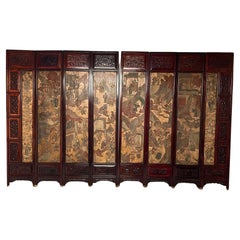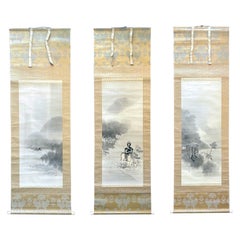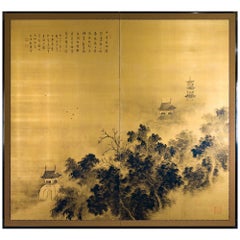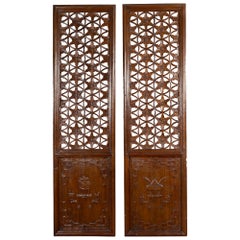Wood Paintings and Screens
to
77
526
79
690
27
8
16
14
9
8
5
5
2
2
1
1
1
70
236
384
35
113
90
29
14
3
18
3
7
12
18
12
8
1
772
768
725
538
490
616
566
330
214
39
725
712
714
23
4
2
2
2
Material: Wood
Unusual Eight Panel Chinese Coromandel Screen circa 1700-1800 with Carved Frame
Located in Manhasset, NY
Chinese Coromandel Screen, 18th Century, Rosewood, 8 Panel, Painted, Figural, Depicting Flying Geese
One of a kind. Chinese Coromandel screen from the late 1700s with a fabulous ros...
Category
Mid-19th Century Chinese Chinoiserie Antique Wood Paintings and Screens
Materials
Rosewood
$30,000 Sale Price
50% Off
Rare Triptych Scroll Paintings by Watanabe Seitei Meiji Period
Located in Atlanta, GA
A set of three paintings of ink and watercolor on silk mounted within brocade borders as scrolls by Watanabe Seitei (1851-1918). This is a very rare an...
Category
Early 1900s Japanese Japonisme Antique Wood Paintings and Screens
Materials
Brocade, Silk, Wood
Japanese Two-Panel Screen with Chrysanthemums & Morning Glory Flowers, Ca. 1900
Located in New York, NY
Japanese Two-Panel Screen with Chrysanthemums & Morning Glory Flowers, Ca. 1900
PERIOD
Meiji/Taisho Period – ca. 1900/1920
DIMENSIONS
Width: 54 inches
Height: 53.5 inches
Category
Early 1900s Japanese Japonisme Antique Wood Paintings and Screens
Materials
Wood
Japanese Two Panel Screen, Chrysanthemums
Located in Hudson, NY
Beautiful white chrysanthemums are emphasized by heavy gold on a soft floral landscape, while gold clouds create a striking and dream-like floral scene. Gold leaf and gofun with min...
Category
Early 18th Century Japanese Antique Wood Paintings and Screens
Materials
Gold, Gold Leaf
Japanese Two-Panel Screen Temples Through Misty Forest
Located in Hudson, NY
Japanese two-panel screen: Temples Through Misty Forest. Chinese School landscape ink painting on gilded silk by Yukimatsu Shunpo, signed and dated 1924. Yukimatsu Shunpo was born in...
Category
1920s Japanese Taisho Vintage Wood Paintings and Screens
Materials
Silk, Wood
Pair of 19th Century Chinese Wooden Panels with Floral Motifs and Carved Objects
Located in Yonkers, NY
A pair of Chinese wooden panels from the 19th century, with floral motifs and carved objects. Created in China during the 19th century, each of th...
Category
19th Century Chinese Antique Wood Paintings and Screens
Materials
Wood
Japanese Edo Two Panel Screen Children Playing Catching Fish
Located in Rio Vista, CA
Delightful late 18th century/early 19th century Japanese Edo period two panel byobu screen depicting children at play near a riverbank and catching fish. Painted in the Maruyama-Shij...
Category
18th Century Japanese Edo Antique Wood Paintings and Screens
Materials
Silk, Wood, Paper
Painted canvas representing birds in the savannah. Contemporary.
Located in Saint-Ouen, FR
Painted canvas representing orange-colored birds in the savannah, with large leaves in the foreground and bushes in the background. Wands made from copper foil.
Work of contemporary...
Category
20th Century French Wood Paintings and Screens
Materials
Gold Leaf
Antique Japanese Kano School Painting by Yosenin Korenobu
Located in Prahran, Victoria
Six-panel Kano School tiger screen by Yosenin Korenobu (1753-1808). Sumi-e ink on paper, late 18th century.
Dimensions: H 169cm x W 382cm.
Category
Late 18th Century Japanese Edo Antique Wood Paintings and Screens
Materials
Wood, Paper
Early Chinese Export Reverse Glass Painting Depicting Deer, Monkeys & Wildlife
Located in Atlanta, GA
This exquisite early and highly unusual Chinese export reverse glass painting from the Qing Dynasty (1644-1911) beautifully depic...
Category
Early 19th Century Chinese Chinese Export Antique Wood Paintings and Screens
Materials
Glass, Giltwood, Paint
$4,716 Sale Price
20% Off
Pair of Japanese Ink Hanging Scrolls Kano Tanyu
By Kano Tan'yu 1
Located in Atlanta, GA
A fine matching pair of hanging scrolls ink on paper mounted in green brocade borders circa Edo period (17-18th century). The Kano school painting depicts wild geese in the reeds by the margin of water, a popular subject borrowed from the Chinese tradition. Both painting were signed as Tanyu with a red seal of Morinobu, his birth name. The storage box is also present and was inscribed with the title Painting of Geese and Reeds and Kano Tanyu...
Category
Late 17th Century Japanese Japonisme Antique Wood Paintings and Screens
Materials
Wood, Paper
$6,000 / set
Pair of Chinese Turned Square Courtyard Panels, c. 1850
Located in Chicago, IL
Designing the intricate patterning of these 19th century northern Chinese lattice panels was like solving a puzzle. Skilled craftsmen pieced together handcut lengths of wood, precisely interlocking them to create a repeating diamond pattern...
Category
Mid-19th Century Chinese Qing Antique Wood Paintings and Screens
Materials
Elm, Paper
Large Continental 6 Panel Leather Screen with Architectural Landscape Design
Located in Atlanta, GA
Large Continental 6 Panel Leather Screen with Architectural Landscape Design ca. 1800
Category
Early 19th Century Antique Wood Paintings and Screens
Materials
Leather, Wood
Chinese Early 20th Century Brown and Red Two-Panel Screen with Calligraphy
Located in Yonkers, NY
A Chinese two-panel screen from the early 20th century, with carvings, gilt motifs and calligraphy. Created in China during the early years of the 20th century, this screen features ...
Category
Early 20th Century Chinese Wood Paintings and Screens
Materials
Wood
Meiji Chrysanthemum Masterpiece
Located in Fukuoka, JP
Step into a world of timeless beauty with our exceptional six-panel screen from the Edo-Meiji period. In impeccable condition, each panel features stunning paintings of chrysanthemum...
Category
19th Century Japanese Meiji Antique Wood Paintings and Screens
Materials
Gold
Interlock Screen 4 Panels By André Fu Living
By André Fu
Located in Admiralty, HK
a timeless screen designed to integrate seamlessly into all interiors. be it used as a backdrop behind a sofa setting, or a partition besides a dining room, its ability to provide a degree of screening gives endless possibilities. crafted entirely with ash strips that interlock and thoughtful detailing that allows each panel to fully fold back, it is a piece to entice all spaces.
Wooden screen with 4 foldable panels in oak with bronze detail on the top edge, with wooden hinges.
Category
2010s Chinese Modern Wood Paintings and Screens
Materials
Bronze
$21,023 / item
c. 1800 English Fire Pole Screen Needlepoint/Tapestry Stand
Located in Louisville, KY
Unique and finely made, this English Regency pole screen is constructed of beautiful Rosewood that’s hand-turned, carved and jointed, topped with a delicate finial with three cabriol...
Category
Early 19th Century English Regency Antique Wood Paintings and Screens
Materials
Textile, Wood, Rosewood
Antique obi textile art " Pine forest ~ Longivety ~ " by ikasu Green , Japan
By Kimono ikasu
Located in Setagaya City, JP
<< Story behind the work >>
Obi fabric I used for this artwork is taken from three different over 100-years-old antique sashes, and is framed in wood taken from antique chest-of-dra...
Category
Early 20th Century Japanese Japonisme Wood Paintings and Screens
Materials
Gold Leaf
19th Century Carved Chinese Windows, Set of 4
Located in Atlanta, GA
This set of four, Chinese carved window screens is from an 19th century house from the Shanxi province of China. Carved from Chinese Northern Elm...
Category
Mid-19th Century Chinese Antique Wood Paintings and Screens
Materials
Elm
$4,500 / set
Ronde by CHEN Yiching, Contemporary Four-Panel Nihonga Screen (Hand-Painted)
By Chen Yiching
Located in PARIS, FR
'Ronde' (Round) is a hinged four-panel screen covered with stretched paper on the front. The surface is hand-painted with mineral pigments and depicts a floral composition. Plants wi...
Category
2010s French Wood Paintings and Screens
Materials
Paint, Paper, Wood, Fabric
Antique kimono textile art "Kobachi ~ Green Collection ~" by ikasu Green, Japan
By Kimono ikasu
Located in Setagaya City, JP
This work is inspired by the green color palette, and is framed in paulownia wood originally used for a kimono chest-of-drawers.
In this artwork, the aim was to capture the wide pal...
Category
1920s Japanese Japonisme Vintage Wood Paintings and Screens
Materials
Silk, Wood
Chinese Wooden Screen with Reverse Glass Painted Panels
Located in London, GB
This exquisite Chinese folding screen has been crafted from wood, and fitted with Fine reverse glass paintings. The screen is composed of six wooden panels. These panels are subdivid...
Category
Early 1900s Chinese Chinese Export Antique Wood Paintings and Screens
Materials
Wood, Glass
Chinese Phoenix and Auspicious Fruit Canopy Painting, circa 1850
Located in Chicago, IL
The owners of this work of art were likely the only two people in the world lucky enough to have access to its beauty. The experience of art itself can be an intimate one, and this b...
Category
Mid-19th Century Chinese Qing Antique Wood Paintings and Screens
Materials
Pine
Six Panel Japanese Screen: Winter Scene of Pine, Plum, and Bamboo
Located in Hudson, NY
Japanese Six Panel Screen: Winter Scene of Pine, Plum, and Bamboo Under Crescent Moon. Pine, plum and bamboo are known as the three friends of winter, because they all thrive and bl...
Category
Early 20th Century Japanese Taisho Wood Paintings and Screens
Materials
Paper, Wood
Philippine Handcrafted Solid Mahogany Carved Screen, Philippines, 1930
Located in Madrid, ES
Traditional Philippine hand carved solid Mahogany 3-panel see-through screen.
Category
1930s Philippine Japonisme Vintage Wood Paintings and Screens
Materials
Wood
Late Edo Silver-leafed Screen
Located in Fukuoka, JP
Late Edo Silver-leafed Screen
Period: Late Edo to Meiji
Size: 186 x 176 cm (73.2 x 69.3 inches)
SKU: PL42
Embracing the essence of the Late Edo to Meiji transition, this oxidized s...
Category
19th Century Edo Antique Wood Paintings and Screens
Materials
Silver Leaf
Painted canvas representing a marmoset on a floral background. Contemporary.
Located in Saint-Ouen, FR
Painted canvas representing a marmoset in a floral decoration.
Work of contemporary French artists.
Dimensions: H 160 x W 100 cm
Reference: LS6132675Y
We have another canvas all...
Category
20th Century French Wood Paintings and Screens
Materials
Gold Leaf
Framed Pair of Vintage South Asian Paintings - Gouache & Gilt - 20th Century
Located in Chatham, ON
Pair of vintage South Asian gouache paintings on paper with gilt highlights - contained in a single bevel edged matte and frame under glass - mid 20th century.
Excellent vintage con...
Category
Mid-20th Century Indian Anglo-Indian Wood Paintings and Screens
Materials
Glass, Wood, Paint, Paper
Japanese Asian Edo Period Tosa School Original Painting Imperial Court Officials
Located in Studio City, CA
A beautiful and very engaging Edo Period (1603-1868) Japanese Tosa school original painting featuring two officials from the Imperial Court.
The Tosa school (土佐派,) of Japanese pai...
Category
1830s Japanese Edo Antique Wood Paintings and Screens
Materials
Wood, Paint, Paper
Pair of Chinese Hand Carved Jade and Wood Table Screens
Located in Guaynabo, PR
This is a 19th century pair of Chinese hand carved oval jade and hard stone table screens with wood stands. They depict a semitransparent large egg sh...
Category
19th Century Chinese Chinese Export Antique Wood Paintings and Screens
Materials
Jade
$3,040 Sale Price / set
20% Off
Antique 19th Century Chinese Carved Rare 5-Panel Screen Room Divider
Located in West Hartford, CT
This rare antique 19th Century Chinese 5 panel Coromandel screen features incredible craftsmanship and period detail. The five panels are carved on both sides, with one side depicti...
Category
Late 19th Century Chinese Chinoiserie Antique Wood Paintings and Screens
Materials
Wood
Japanese Six-Panel Screen Women of the Court in the Garden
Located in Hudson, NY
Japanese six-panel screen: Women of the Court in the Garden. Edo period (circa 1700) painting of an early Kano school subject matter: nobility socializing in a coutryard garden. Deta...
Category
Early 1700s Japanese Edo Antique Wood Paintings and Screens
Materials
Gold Leaf
Japanese 2-Panel 'Shunga' Screen with Finely Painted Erotic Depictions of Lovers
Located in Prahran, Victoria
A very finely painted two panel 'shunga' screen with scenes of naked erotic lovers in union.
The scene on the left panel simply depicts the lovers in ...
Category
Mid-20th Century Japanese Showa Wood Paintings and Screens
Materials
Wood, Paper
Large Antique Chinese Hand Painted Wallpaper Section in Carved Hardwood Frame
Located in Austin, TX
A wonderfully charming large and colorful Chinese hand painted wallpaper section in a carved and shaped hardwood frame. The wallpaper dates to the first half of the 20th century or e...
Category
Early 20th Century Chinese Chinese Export Wood Paintings and Screens
Materials
Hardwood, Paper
Japanese Signed painting on silk depicting Bamboo and Bird
Located in Fukuoka, JP
Japanese Signed painting on silk depicting Bamboo and Bird
This exquisite painting on silk depicts a beautiful bamboo and a bird, signed by the talented artist Waichi.
The pi...
Category
20th Century Japanese Wood Paintings and Screens
Materials
Silk, Wood
Art Deco Garden Screen 4 Panels By André Fu Living
By André Fu
Located in Admiralty, HK
designed as a nod to the beauty of japanese zen gardens, this artfully designed movable screen is visually pure in its composition, yet intricate at the same time. crafted in solid a...
Category
2010s Chinese Modern Wood Paintings and Screens
Materials
Ash
$20,618 / item
Lacquered Wooden Screen Decorated With A Peacock And A Refined Landscape
Located in Milano, IT
Majestic and rare lacquered wooden screen with an elegant peacock in the center that stands out among golden and silver clouds. The peacock is depicted on a gnarled cherry blossom tr...
Category
Early 20th Century Japanese Japonisme Wood Paintings and Screens
Materials
Wood
$8,411 Sale Price
20% Off
Japanese Two Panel Screen: Antique Kimono Fabric Mounted on Screen
Located in Hudson, NY
Japanese Two Panel Screen: Late Nineteenth Century Kimono Fabric Mounted on Early Twentieth Century Screen. In the Heian period (eighth century to the twelfth century), noblemen wou...
Category
Early 20th Century Japanese Meiji Wood Paintings and Screens
Materials
Silk, Wood, Paper
France Antique "Brittany" Paul Fouillen Arts Crafts Pyrography Panels
Located in South Burlington, VT
From an old New England collection of fine Arts & Crafts furnishings.
Two large all original unique works of art, circa 1920
This is a beautiful set of two (2) hand incised and...
Category
Early 20th Century French Arts and Crafts Wood Paintings and Screens
Materials
Brass
Italian Neoclassical Bird and Garden Vignette Folding Screen
Located in Queens, NY
Italian neoclassical-style four panel folding screen hand-painted with an array of birds in a garden on the front and brown detailing on the reverse.
Category
20th Century Neoclassical Wood Paintings and Screens
Materials
Canvas, Wood
Wood Wall Panel from Indonesia, Mid 20th Century
Located in New York, NY
A vintage wood panel from Indonesia, circa 1920. Hand-carved teak wood, with its original grey/blue color paint in the frame, naturally distressed b...
Category
1920s Indonesian Arts and Crafts Vintage Wood Paintings and Screens
Materials
Teak
$720 Sale Price
20% Off
Arts And Crafts Fire Screen, Signed Arthur Grinnell 1854-1924
Located in South Burlington, VT
From an important thirty year old New England collection of American Folk Art Pyrography
Arthur Grinnell Fire Screen (1854-1924)
This original circa 1910 fire screen- framed pyrogr...
Category
Early 20th Century American Arts and Crafts Wood Paintings and Screens
Materials
Wood
Pair of Mughal Style Portait Panels
Located in San Marino, CA
Pair Hand-Painted Indian Portait Panels from the 20th Century.
Category
20th Century Italian Wood Paintings and Screens
Materials
Wood
$16,000 / set
VIntage kimono textile art "Geometry ~Chrysanthemums" by ikasu, white, red Japan
By Kimono ikasu
Located in Setagaya City, JP
This work is inspired by traditional Japanese natural symbolism, and is framed in paulownia wood originally used for a kimono chest-of-drawers.
It is elegantly framed with paulownia...
Category
1960s Japanese Japonisme Vintage Wood Paintings and Screens
Materials
Silk, Wood
Chinese Peony and Pheasant Canopy Painting, circa 1850
Located in Chicago, IL
The experience of art itself can be an intimate one and this bed canopy, hand painted over 100 years ago by an artist in Canton, was more intimate than most. Delicately painted birds...
Category
Mid-19th Century Chinese Qing Antique Wood Paintings and Screens
Materials
Pine
Japanese Six-Panel Screen Waterfall and Cherry in Audubon Landscape
Located in Hudson, NY
Japanese six-panel screen: waterfall and cherry in Audubon landscape, Edo period painting, 18th century, depicting summer and spring. A Kano Schoo...
Category
Mid-18th Century Japanese Edo Antique Wood Paintings and Screens
Materials
Gold Leaf
1970s Chinese Export Black Coromandel Carved Laquer Panel by Zhongkun
Located in Melbourne, AU
Chinese export coromandel panel titled 'Guo Jiu Feng En' (Xijiu Seal?), and signed by the artist 'Zhongkun'.
This striking Chinese lacquer panel showcases a traditional technique wi...
Category
1970s Hong Kong Chinoiserie Vintage Wood Paintings and Screens
Materials
Plywood, Lacquer
Chinoiserie Palm Oval Paintings
Located in Sturminster Marshall, Dorset
A pair of carved giltwood Chippendale crossed palm frames, with inset hand-painted chinoiserie portraits of 18th century oriental nobility.
We a...
Category
21st Century and Contemporary English Chippendale Wood Paintings and Screens
Materials
Gold Leaf
$6,531 / set
Japanese Two Panel Screen Nara Deer in Gentle Yoshino Landscape
Located in Hudson, NY
Japanese two panel screen: Nara Deer in Gentle Yoshino Landscape. Yoshino is in the Nara Prefecture, an area famous for these small and tame deer native to J...
Category
Early 1900s Japanese Meiji Antique Wood Paintings and Screens
Materials
Gold Leaf, Silver Leaf
Antique kimono textile art " Plum Blossom Night ~Resilience~ " by ikasu Japan
By Kimono ikasu
Located in Setagaya City, JP
This artwork uses antique fabric from Taisho era (early 1920ies) kimono and paulownia wood taken from antique kiritansu - chest-of-drawers used initially to keep kimonos.
It is eleg...
Category
1920s Japanese Japonisme Vintage Wood Paintings and Screens
Materials
Silver Leaf
Antique kimono textile art " Waves and clouds ~Eternity~ " by ikasu Beige, Japan
By Kimono ikasu
Located in Setagaya City, JP
This work is inspired by traditional hand-dying technique edo-komon, and is framed in paulownia wood originally used for a kimono chest-of-drawers.
It is elegantly framed with paulo...
Category
1920s Japanese Japonisme Vintage Wood Paintings and Screens
Materials
Silk, Wood
Japanese Meiji Period Six-Panel Screen with Blue Lake and Flowers, Ca. 1900
Located in New York, NY
Japanese Meiji Period Six-Panel Screen with Blue Lake and Flowers, Ca. 1900
Meiji Period (1868-1912)
DIMENSIONS
Length: 145 inches
Height: 69.5 inches
Category
Early 1900s Japanese Japonisme Antique Wood Paintings and Screens
Materials
Wood
Vintage kimono textile art "View from the Window ~Maple&Plum~" by ikasu, Japan
By Kimono ikasu
Located in Setagaya City, JP
This work is a glorious nod to buddhist temples circle windows, with beautiful Japanese garden scape seen outside. Golden leaf on the border of a frame is an expression of light goin...
Category
1930s Japanese Japonisme Vintage Wood Paintings and Screens
Materials
Gold Leaf
French Mashrabiya Screen
Located in Southampton, GB
French Mashrabiya style Screen.
Four panelled structure, with a Charles Dudyout design influence.
France, circa 1920.
Height - 135cm
Panel Width - 34.5cm
Total Width - 139cm
Indivi...
Category
Early 20th Century French Wood Paintings and Screens
Materials
Oak
$1,700
Japanese Screen "the Song of Everlasting Sorrow"
Located in PARIS, FR
Six-panels screen depicting the exit from the city of a Chinese emperor on horseback and his concubine in a luxurious palanquin.
It may be a scene illustrating the poem The Song of Everlasting Sorrow (Chang hen ge, ???) written by Bai Juyi (772-846), which recounts the tragic love story between the emperor Ming Huang (also known as Tang Xuanzong, 685-762) and his favorite concubine, the beautiful Yang Guifei...
Category
Late 17th Century Japanese Antique Wood Paintings and Screens
Materials
Silk, Wood, Paper
Painted canvas representing carp. Contemporary work.
Located in Saint-Ouen, FR
Painted canvas, or decorative panel, representing carp.
Contemporary French work.
Dimensions: H 120 x W 100 cm
Reference: LS6028675A
Raw linen canvas hand painted with natural pi...
Category
20th Century French Wood Paintings and Screens
Materials
Copper, Gold Leaf
Pair of Antique Asian Mother of Pearl Inlaid Hardwood Panels
Located in West Palm Beach, FL
Pair of Antique Asian Mother of Pearl Inlaid Hardwood Panels.
A pair or Vietnamese works Each one standing over 6-Feet tall, Intricately inlaid with numerous characters and threads, ...
Category
Late 19th Century Chinese Chinese Export Antique Wood Paintings and Screens
Materials
Mother-of-Pearl, Hardwood
$1,920 Sale Price / set
20% Off
Chinese Reverse Painted Glass and Hardwood Table Screen
Located in Austin, TX
An unusual table screen featuring a reverse glass painted portrait of a young noble lady set into a hardwood frame and stand.
The beautiful maiden has a roun...
Category
Mid-19th Century Chinese Qing Antique Wood Paintings and Screens
Materials
Glass, Hardwood
Japanese Six-Panel Screen Plovers in Flight Over Coastal Landscape
Located in Hudson, NY
Japanese six-panel screen: Plovers in flight over coastal landscape. Late Edo - Early Meiji period, circa 1870, painting of plovers flying over cresting waves. Sumi ink on mulberry p...
Category
1870s Japanese Antique Wood Paintings and Screens
Materials
Silk, Wood, Paper
Japanese Two-Panel Screen Three Jewels of Buddhism
Located in Hudson, NY
Japanese two-panel screen: Three Jewels of Buddhism. Meiji period (1868-1912) painting. The three jewels of Buddhism are the teacher, the lesson, and the ...
Category
Late 19th Century Japanese Meiji Antique Wood Paintings and Screens
Materials
Silk, Wood, Paper
Recently Viewed
View AllMore Ways To Browse
Japanese Red Lacquer Frame
Lattice Panel Wood
Hanging Japanese Screen
Japanese Lattice
Japanese 19th Century Meiji Period Silk Painting
Japanese Buddhist Screen
Japanese Carved Screen
Japanese Screens And Doors
Monkey Screen
Japanese Autumn Screen
Japanese Screens Six Fold
Japanese Wood Room Divider
Kyoto Silk Painting
Japanese Dragon Painting
Japanese Birds Painted On Silk
Heian Period
Japanese Crane Panel
Japanese Divider Screen





